For a bird, staying clean is not just a requirement for comfort but a necessity for survival. Their feathers have to function properly for them to fly so they can gather food and escape predators. So how do birds clean themselves and ensure they are precision flying machines?
Birds clean themselves in several different ways. The main way they clean is by preening. This process, in some birds, involves a gland at the base of their tail that produces an oil that they spread over their feathers. Birds also clean by bathing and a rather strange activity called anting.
Continue reading to discover more about the techniques birds use to clean themselves. We will explore all the ways they maintain their feathers, including the completely bizarre things they do that would seem to do anything but keep them clean.

Preening Is Cleaning
Preening is one of the most essential things a bird must do and most birds will spend around 10% of their day doing it. In some species, it takes up around 20% of their day.
Many bird species preen with the help of a gland at the base of their tails. It is called the uropygial gland and it secretes a fluid containing fatty acid, fat, and wax that birds use to clean and waterproof their feathers.
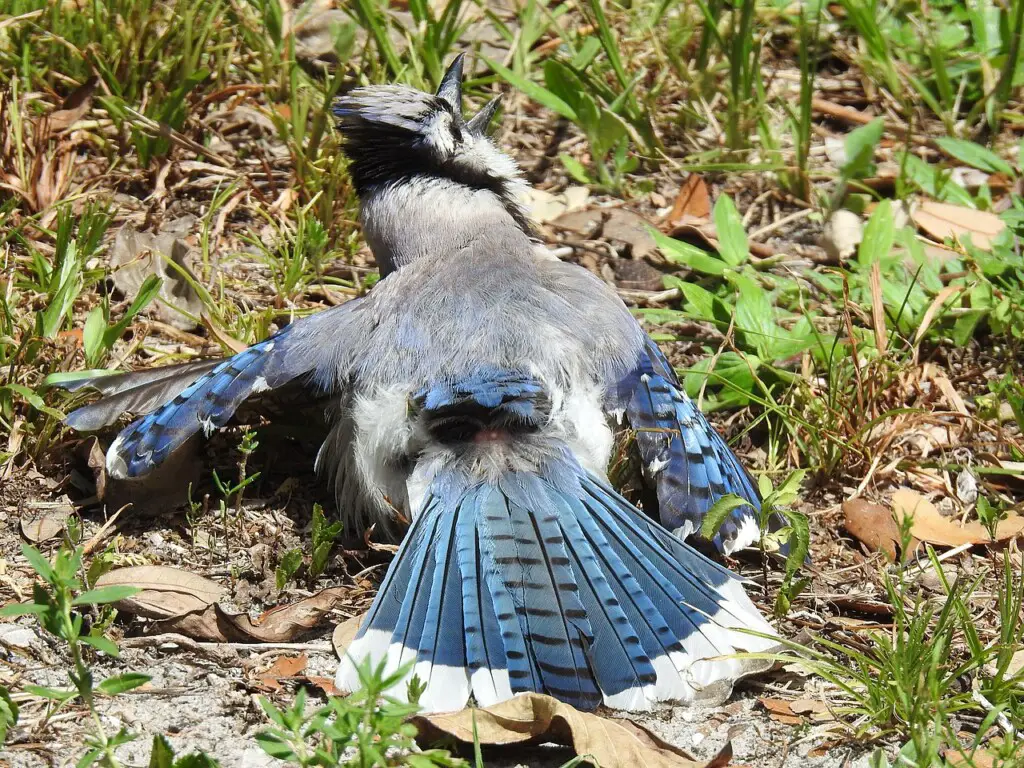
When preening, a bird will reach back to its uropygial gland, collect some oil on its beak, and then smear the oil on each body, wing, and tail feather from base to tip. This helps to clean off any dirt, bacteria, or parasites that may be present on the feathers.
Preening doesn’t just keep a bird clean, it also resets all the barbs of the feathers and puts them back in the correct place for flight.
The oil from the uropygial gland helps to keep a bird’s feathers water repellant but is not necessary for them to be waterproof. This was proved by removing the uropygial glands from ducks. When this was done, the ducks’ feathers did not lose their waterproofing ability.
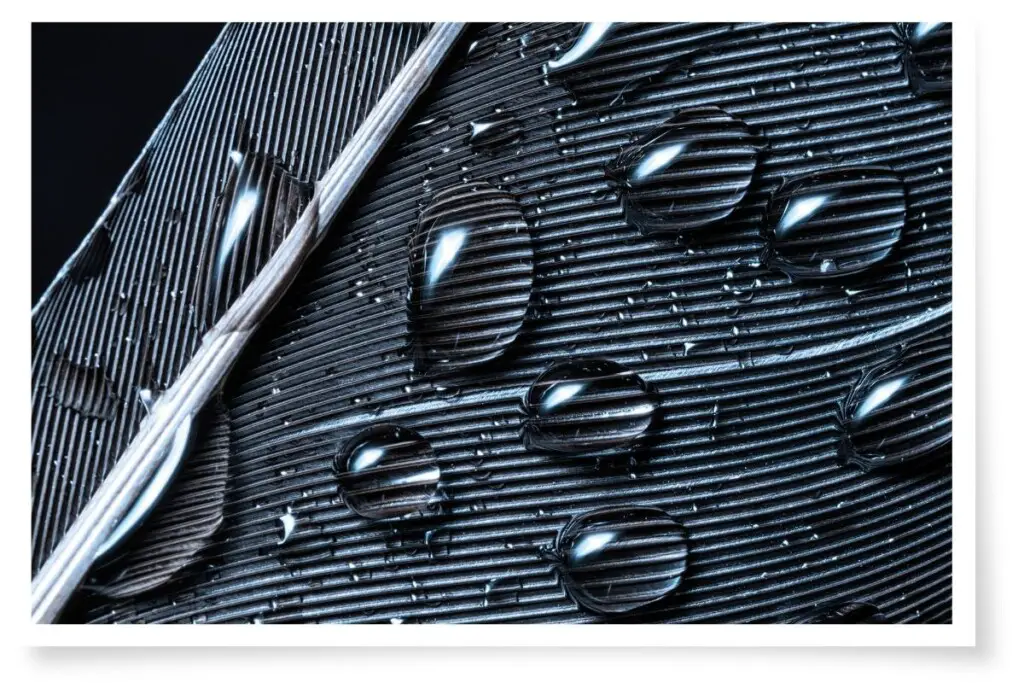
The oil seems to act like a kind of conditioner that prevents the feather barbs and barbules from becoming brittle and breaking prematurely.
At the end of a preening session, a bird will usually fluff up all of its feathers and shake like a wet dog. This shakes free any remaining dirt or loose down feathers that may remain.
They will especially shake like this after a good water bath, which is another way birds clean themselves.
Nothing Beats A Good Bath
Bathing in water is something that birds love to do. If you have a birdbath in your yard, you will likely have seen them do this on more than one occasion.

Birds will bathe in water as this removes dirt and grime from their feathers. It also helps to restore the shape of the feathers as everyday use can leave them bent and misshapen.
The usual technique starts with fluffing up the feathers to open up as much surface area as possible. The bird will then dip its head in the water and then jiggle about, splashing the water into a frenzy. It will then shake and ruffle the feathers to dislodge any dirt or dust within them.
After bathing a bird will always begin an intense preening session. This is to ensure that all the dirt and grime have been removed and also to get the feathers back into their correct shape and positioning.
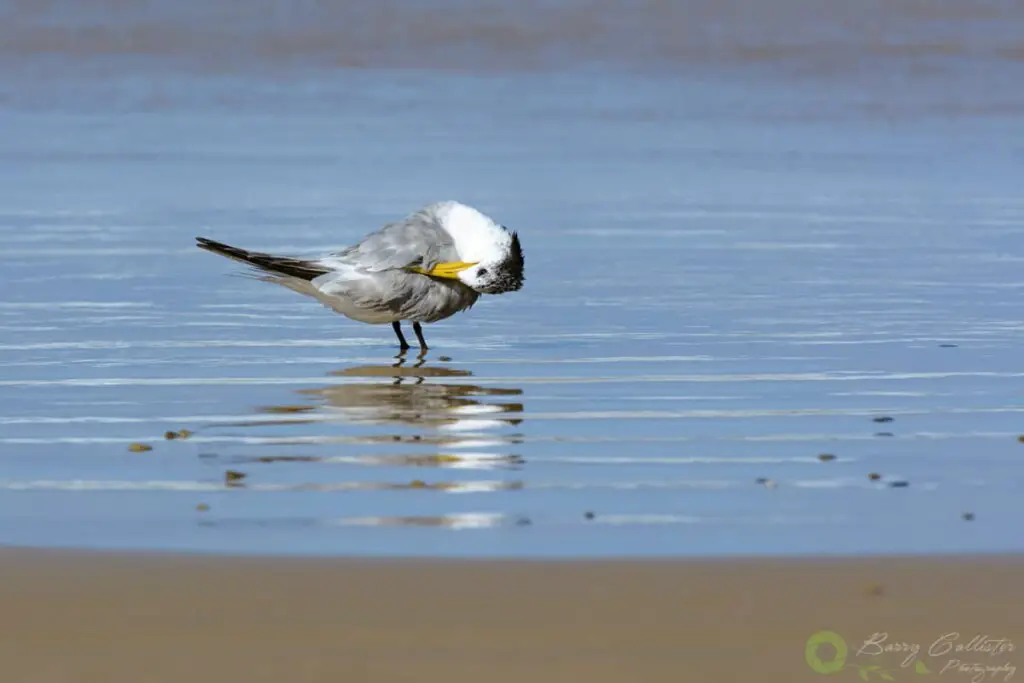
However, water is not the only thing birds will bathe in. Those birds that do not have access to water choose to take a dirt bath instead.
Discover the remarkable ways birds find water in this article here on my blog.
Do Birds Clean With Dirt?
Birds do clean themselves with dirt. Taking a dirt bath followed by a vigorous shake helps to remove any parasites within their feathers. A dirt bath will remove chewing lice, louse-flies, bugs, mites, fleas, and ticks. The dust may also help balance the oil content on their feathers.
House Sparrows are one species that will do this. In most cases, house sparrows will also have access to water but dust baths are one of their common behaviors. Many species engage in both water and dust bathing.
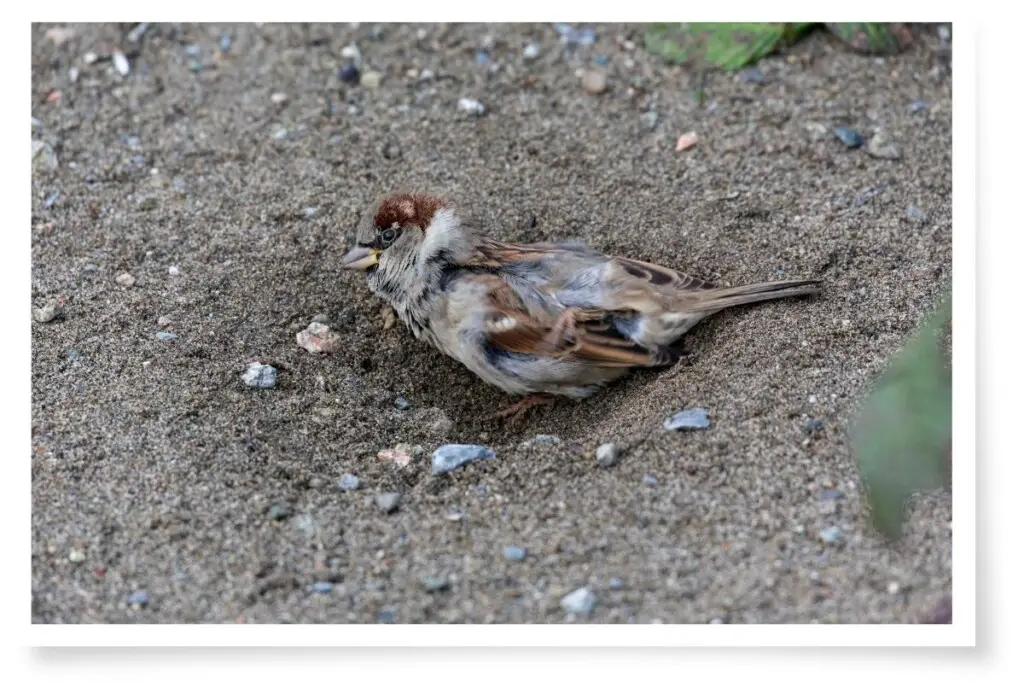
A bird will use similar movements to water bathing when taking a dust bath. They crouch low in the dirt or sand and ruffle their feathers and wings to shake dust up and over their bodies. When they are finished, they leave bowl-shaped depressions in the ground underneath them.
Another theory about why birds will dust bathe has to do with their preen oil. The right amount of oil in the feathers is beneficial for waterproofing and also inhibits bacteria. Too much oil may cause the feathers to stick together which would provide food for bacteria and parasites.
Dusting may help to balance out the oil level or may even change the properties of the oil in some way.
What Is Anting?
Anting is an activity a bird will carry out to clean and protect its feathers from bacteria and parasites. A bird will lay down and let ants crawl all over its body, possibly removing any parasites from its feathers. Birds also use anting in other ways and with other insects or objects.
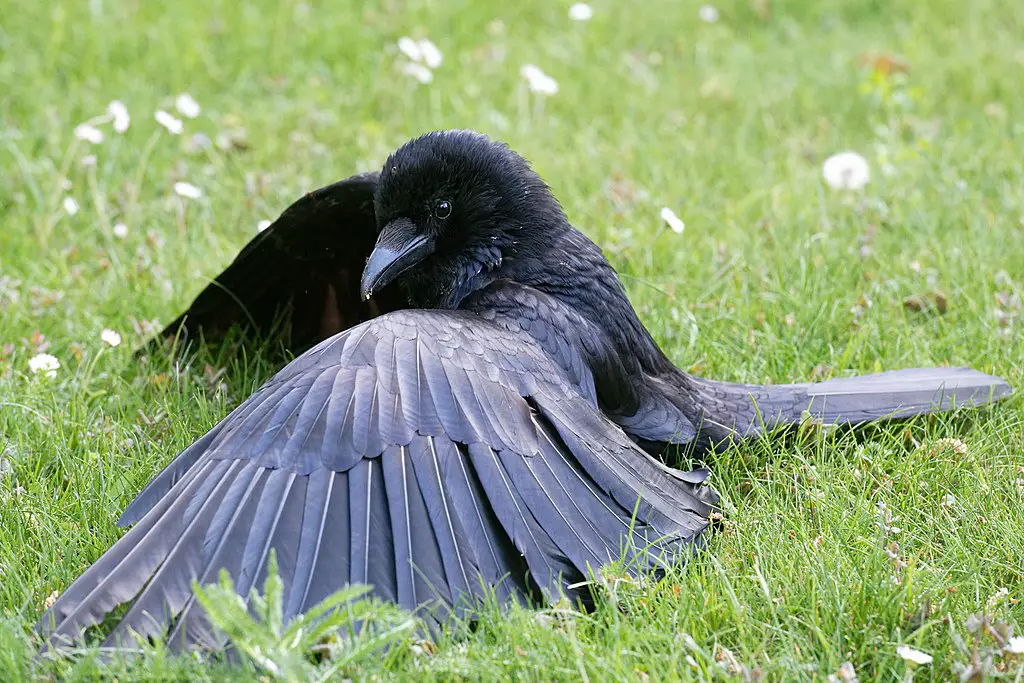
Anting is often confused with sunning where a bird will lay on the ground with wings outspread, seemingly soaking up the sun. This may also remove feather-degrading bacteria or perhaps control feather lice by either killing them or making them move.
The ants are thought to remove any parasites from the bird’s feathers. They also secrete formic acid which may have some anti-bacterial effect.
When anting, a bird will lay down or sit (as in the image of the Crow above) either directly on an ant nest or in an area where ants are gathering. The ants will crawl all over the bird’s body while it remains still and allows them to do so. This is called passive anting.
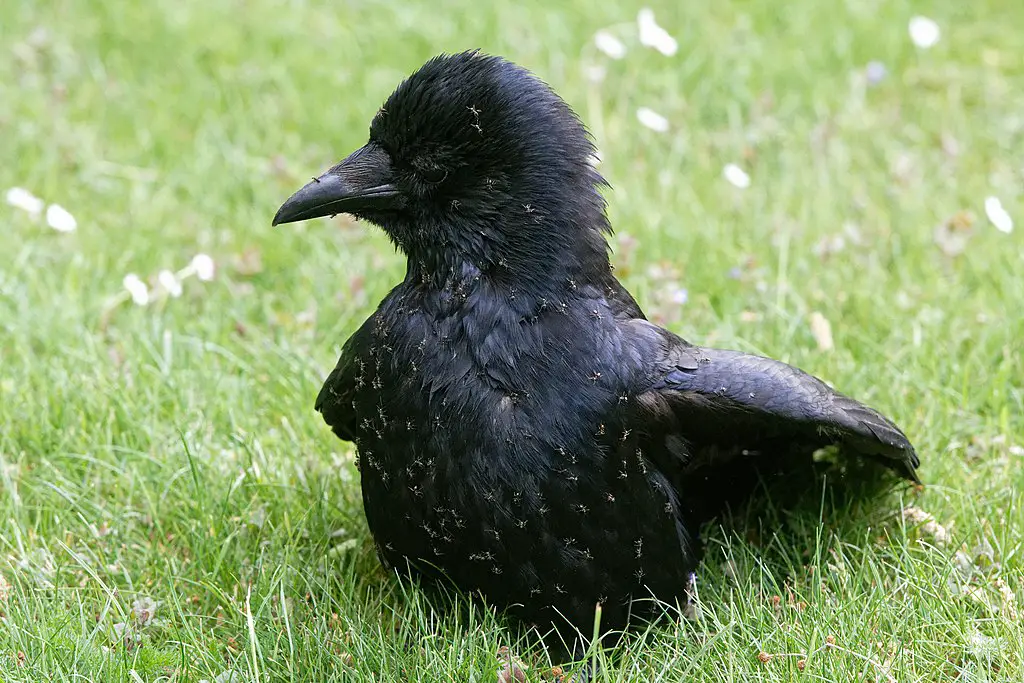
The other type of anting is called active anting. In this instance, a bird will pick ants up in its beak and wipe them over its feathers. This might have a certain antibacterial effect as the ants will secrete their formic acid.
Birds performing this type of anting have also been observed eating the ants afterward. This leads researchers to believe the birds may not be cleaning but picking them up and wiping them over their bodies to get rid of the formic acid before eating them.
Birds have been seen using 24 different species of ants for this process and over 40 other substitute materials including:
- Beetles
- Bugs
- Wasps
- Orange Peel
- Raw Onion
- Hot Chocolate (what?!)
- Vinegar
- Hair Tonic
- Cigarette Butts
- Burning Matches
- Smoke
Birds eat some pretty nasty stuff so do they fart? Find out in this post here on Birdwatch World.
How Do Birds Clean Their Heads?
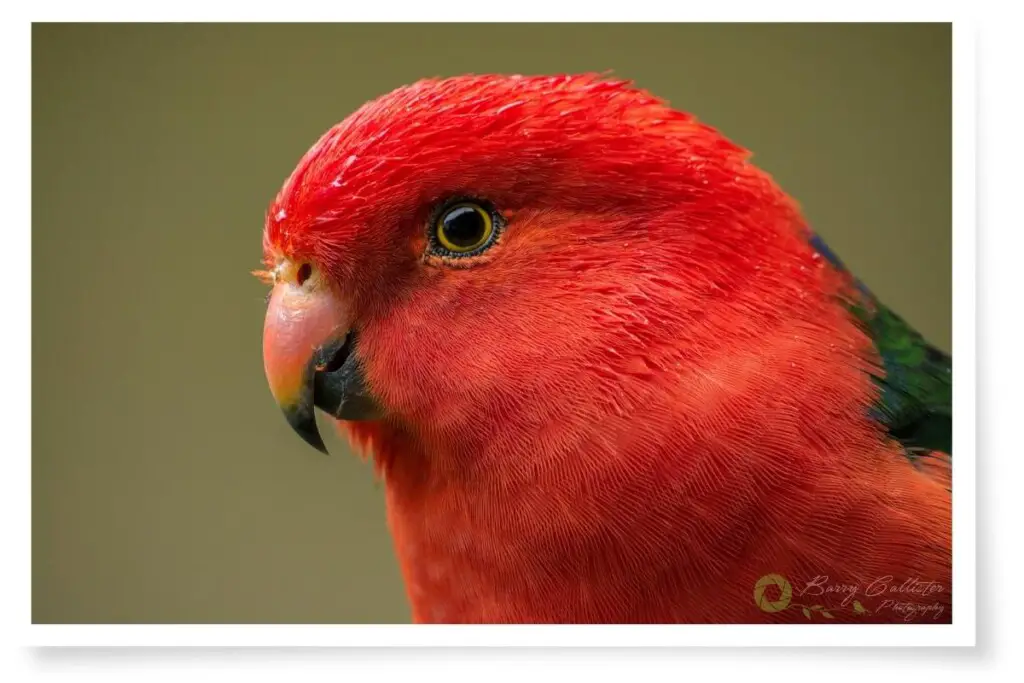
Preening is a very effective way of cleaning the feathers on the wings and the body but how do birds clean their heads? They can’t do this with their own beaks.
Birds clean their heads in a few different ways. The first way they do this is by scratching their heads with their feet. This will dislodge any dirt or debris from within their feathers. They will also clean their heads by bathing in water or engaging in mutual preening with another of their species.
The Common Raven is one species that is known for mutual preening. The correct term for this is allopreening and though it is not that common among birds, it is thought that species from at least 43 families engage in allopreening.
Birds with a uropygial gland will often spread oil from the gland onto their beaks and then rub it onto their heads. They can also rub their head directly on the gland to ensure their head feathers get a good dose of oil.
A few birds even have a special addition to their feet that aids with head preening and grooming. Barn Owls, Nightjars, and Herons have a serrated edge on their third digit that looks like a comb. This may act as a parasite comb, removing lice, ticks, and other unwanted nasties.
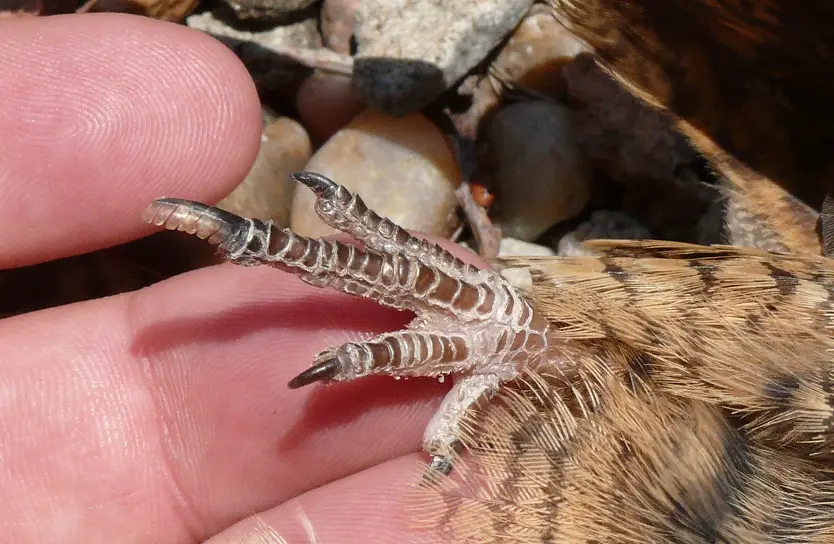
How Do Birds Clean Their Beaks?
After all this preening and cleaning, how do birds clean their beaks?
Birds clean their beaks by wiping them on any hard surface such as sticks, logs, rocks, clotheslines, or birdbaths. They may also use their claws on their feet to scrape debris from their beaks. Some will even bang or tap their beaks onto a hard surface to remove any stubborn food or dirt particles.

Waterbirds will thrash their beaks around in the water to give them a clean. Other species will do this also while taking a bath but those that do not have access to water will choose to just wipe their beaks.
Conclusion
Now you know all the fascinating ways birds clean themselves. I hope you learned many things from reading this article.
Be sure to have a browse around my blog for more content just like this. You could start with some of the links scattered throughout the text above.
Thanks for reading and happy birding…
References
- What It’s Like To Be Bird – David Allen Sibley
- The Life Of Birds – David Attenborough
- Cornell Lab Of Ornithology’s Handbook Of Bird Biology – Irby J. Lovette, John W. Fitzpatrick
- The Life Of Birds – Joel Carl Welty
- Here’s Why Birds Rub Their Beaks on Stuff – Audubon.org

